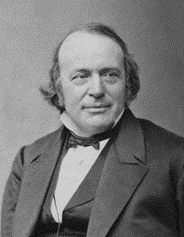Jean Louis Rodolphe Agassiz
1807-1873
Was a Swiss-born American biologist and geologist recognized as an innovative and prodigious scholar of Earth's natural history. Agassiz grew up in Switzerland and received doctor of philosophy and medical degrees at Erlangen and Munich, respectively. After studying with Cuvier and Humboldt in Paris, Agassiz was appointed professor of natural history at the University of Neuchâtel. He emigrated to the United States in 1847 after visiting Harvard University. He went on to become Professor of zoology and geology at Harvard, to head its Lawrence Scientific School, and to found its Museum of Comparative Zoology. Agassiz is known for his regimen of observational data gathering and analysis. He made vast institutional and scientific contributions to zoology, geology, and related areas, including writing multivolume research books running to thousands of pages. He is particularly known for his contributions to ichthyological classification, including of extinct species such as the megalodon, and to the study of geological history, including to the founding of glaciology. Before Agassiz's first visit to England in 1834, Hugh Miller and other geologists had brought to light the remarkable fossil fish of the Old Red Sandstone of the northeast of Scotland. The strange forms of Pterichthys, Coccosteus and other genera were then made known to geologists for the first time. They were of intense interest to Agassiz and formed the subject of a monograph by him published in 1844–45: Monographie des poissons fossiles du Vieux Grès Rouge, ou Système Dévonien (Old Red Sandstone) des Îles Britanniques et de Russie Agassiz and the English geologist William Buckland visited the mountains of Scotland in 1840. There, they found clear evidence in different locations of glacial action. Agassiz’s belief in special creation also extended to perceptions of race. He posited in his lectures at the Lowell Institute in 1846 that the different races of humanity were created independently, each descending from different ancestors (polygenism) and originating in separate zoological provinces at the beginning of time. Agassiz was heavily influenced by research into human cranial capacity conducted by the American anthropologist Samuel George Morton, who possessed an extensive collection of skulls from people of many races. Using measurements taken from many of the skulls’ brain pans, Morton had developed an intellectual hierarchy that placed Caucasians (or whites, who had the largest cranial capacity in Morton’s collection, and thus were presumed to possess the greatest intelligence) at the top and placed Ethiopians (or blacks, who possessed the lowest cranial capacity in Morton’s collection) on the bottom. Agassiz agreed, as he was also affected by his own feelings of pity arising from his initial experiences with African Americans in Philadelphia during his 1846 tour. There he observed the physical traits and behaviour of a small group of African American hotel servants and concluded that they made up a “degraded and degenerate race.”
